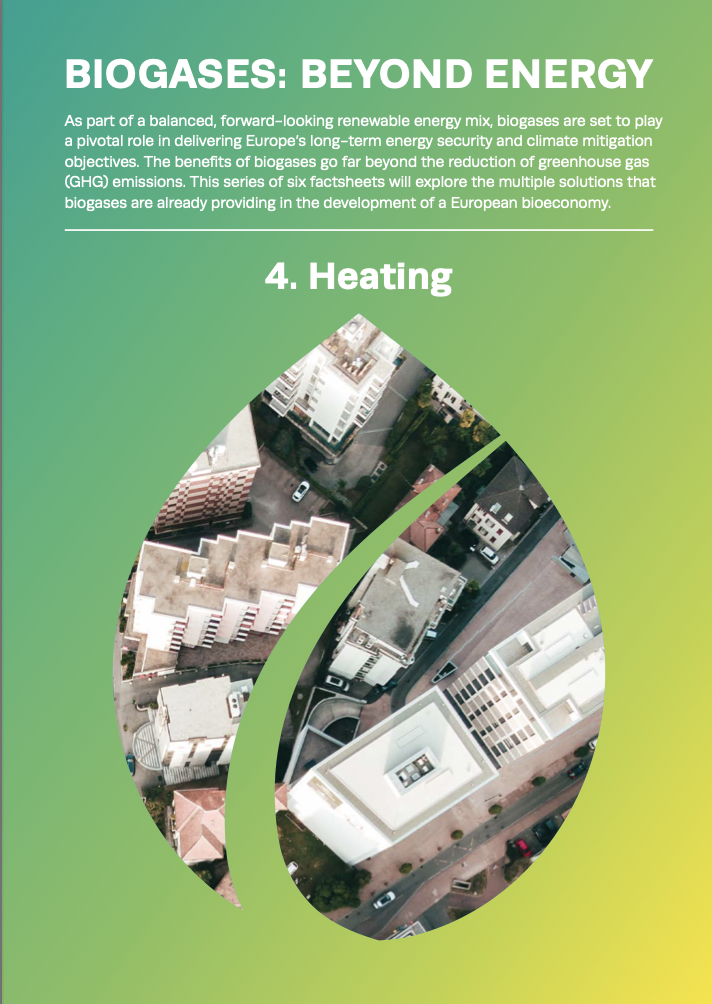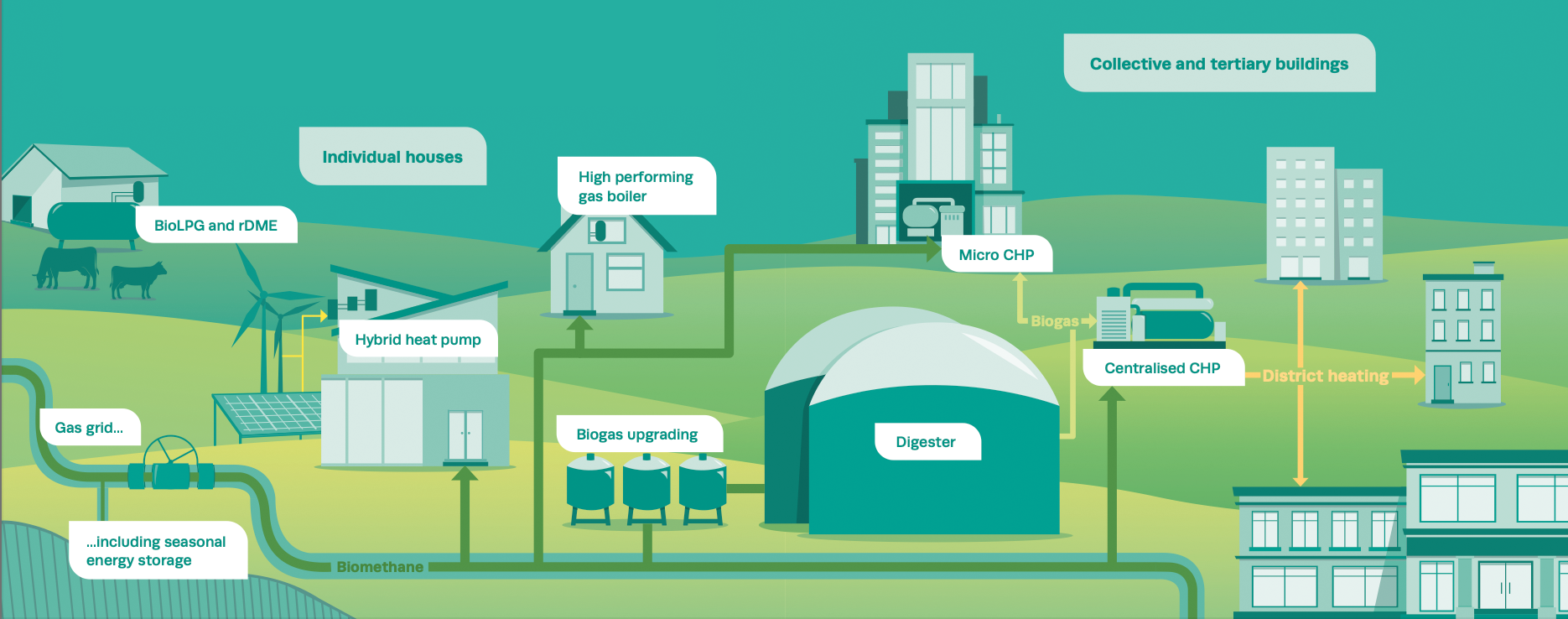Biogases will play a pivotal role in delivering Europe’s long-term energy security and climate mitigation objectives, as part of a forward-looking and balanced renewable energy mix. Besides, their benefits go far beyond the reduction of greenhouse gas (GHG) emissions. That is why attention to this source of renewable energy and scientific developments regarding biogas is increasing.

We are glad to announce that the fourth factsheet of the information campaign of the European Biogas Association (EBA) “Heating” has already been published. The document is focused on features and ways of using biogas and biomethane for heating needs.
You can get acquainted with the three previous ones and the list of future publications by following the link.
Current state of biogas and biomethane use for heating buildings
Buildings are the single biggest consumers of energy in the EU, accounting for 42% of final energy consumption and 36% of CO2 emissions. Only 23% of primary energy for buildings comes from renewable sources. The transition to a carbon neutral building stock will require an array of tools and biogases offer a set of easy-to-implement and cost-effective solutions. Biogases can provide heat for residential and tertiary buildings, either directly on-site or off-site with distribution via a district heating grid. A range of appliances can meet the on-site generation needs of different types of buildings, whether individual or collective, old or newly built. Mini-CHP (for collective buildings) and fuel cell units (for individual houses) generate both heat and electricity. Other options can be combined with electric appliances to provide a highly efficient hybrid solution – for instance, a biomethane-fueled boiler combined with an electric heat pump.

What are the current ways of using biogas and biomethane for heating needs?
Biogases can provide households and tertiary buildings with renewable, cost-competitive heat in the following ways:
- Once injected into gas grids, biomethane (i.e. biogas upgraded to natural gas quality), can fuel end use appliances such as highly efficient gas boilers and gas or hybrid heat pumps, both in individual and in collective buildings.
- Central combined heat and power generation (CHP) units can be run on biomethane and provide heat through a district heating network.
- In rural areas not connected to existing gas networks, raw biogas can directly generate heat to be distributed through a district heating network.
- BioLPG and renewable DME are suitable for individual houses that are remote from gas grids. They can replace fuel oil or fossil LPG.

Will there be enough biogas to replace natural gas in heating?
Natural gas demand for buildings amounted to 1,280 TWh in 2022. This figure is expected to decrease significantly in the long term because of renovation, electrification and the replacement of old boilers with more efficient gas appliances. Sustainable biomethane potential is expected to reach 1,300-1,700 TWh/year by 2050. Biomethane production can therefore be expected to meet the reduced gas demand in buildings as well as supplying other sectors (industry, heavy transport).
Biomethane injected into the gas grid will be the predominant form of biogas used. Shares of biomethane in the grid can quickly become significant at a local and even regional level; in areas with little energy-intensive industry, biomethane would then largely replace natural gas in buildings. Gas grids can also distribute biomethane over wider areas, thanks to the extension of existing grids and targeted reinforcement. In addition, biomethane can be stored in existing underground facilities and be used for heating in the colder months.
Are biogases compatible with existing infrastructure and heating appliances?
Biomethane can act as a natural gas substitute, transported through the natural gas network and used in existing heating appliances or district heating facilities. There is no need to adapt infrastructure or appliances to make them biomethane-compatible. It is an economical way to adopt renewable energy in heating, whether the system relies fully on biomethane or is hybrid, as is the case in hybrid heat pump systems.
Isn’t electrification the best solution?
Daily and seasonal variations are a major feature of heating demand; accommodating them requires large volumes of energy as well as the appropriate distribution infrastructure. The EU gas network is up to this challenge thanks to its scale (it covers over 2.2 million kilometers) and storage capacity (c. 1,000 TWh). It needs to be promptly decarbonised, however, via renewable gases such as biomethane.
Around 77% of the primary energy used in buildings in the EU is still of fossil origin, yet decarbonisation must avoid impairing the ability to meet peak demand. Sustainable biogases will be essential in providing heat to buildings during the transition to a renewable-dominated energy system.
Is it cost-effective to use biogases when renovating a building?
Biogases offer a cost-effective way of decarbonising both existing building stock and buildings subject to renovation. Hybrid heating systems fueled with biomethane are particularly suitable for renovated buildings. The upfront cost of hybrid heat pumps is lower than fully electric systems (up to 25% lower than the cost of a stand-alone electric heat pump). The energy gains are both immediate (thanks to the efficiency of the system) and long- term (once the thermal insulation is completed), which helps spread the investment costs associated with the renovation.
Thermal isolation and the installation of high-efficiency appliances cut energy consumption and thus reduce the energy bill. In the future, smart control systems could enable consumers to switch to gas or electricity in their hybrid heating appliances based on a price signal.
Read more about the information campaign at the link.
Download the first factsheet “Energy system integration” here.
Download the second factsheet “About regenerative agriculture” here.
Download the third factsheet “Transport” here.
Download the fourth factsheet “Heating” here.